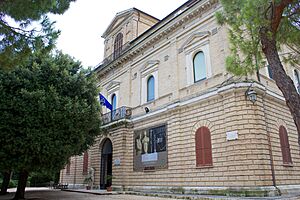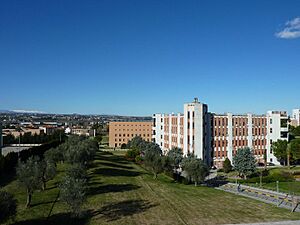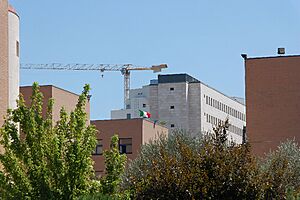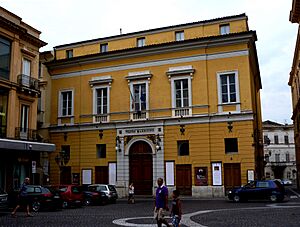D'Annunzio University of Chieti–Pescara facts for kids
|
Università degli Studi "Gabriele d'Annunzio"
|
|
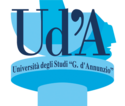 |
|
| Latin: Universitas Studiorum Adriatica | |
| Type | Public |
|---|---|
| Established | 23 June 1960 |
|
Academic affiliations
|
|
| Rector | Liborio Stuppia |
| Director | Giovanni Cucullo |
|
Academic staff
|
1,336 (Fall 2016) |
| Students | 25,268 (Fall 2016) |
| Undergraduates | 21,368 (Fall 2016) |
| Postgraduates | 3,900 (Fall 2016) |
| Location |
,
Italy
|
| Campus | Urban Chieti Campus: 48.9 acres (19.8 ha) Pescara Campus: 6.29 acres (2.55 ha) |
| Colors | Green |
| Nickname | CUS Chieti |
D'Annunzio University (which in Italian is Università degli Studi "Gabriele d'Annunzio", also called Ud'A) is a public university in Italy. It is located in two nearby cities, Chieti and Pescara, in the Abruzzo region.
The university started in 1960 as a higher education school. It was named after a famous Italian writer and poet, Gabriele D'Annunzio. In 1965, it officially became an independent university.
Ud'A has many different parts, including thirteen academic departments. These are organized into two main schools. The university offers programs for students who are just starting, those getting their first degree, and those studying for advanced degrees. It also has international programs.
Research is a big part of what the university does. Each academic area works on scientific projects. They get money for their research from groups in Italy and around the world.
The main campus of D'Annunzio University is in Chieti. It covers about 48.9 acres and has many different kinds of buildings. There is also a smaller campus in Pescara. A special center for learning from a distance is in Torrevecchia Teatina. D'Annunzio University is one of the newer Italian universities to be listed among the world's best.
Contents
History
How it Started
In 1955, leaders from the cities of Chieti and Pescara met. They wanted to create a new university that was not run by the government. Their idea was to start this university in the old town of Chieti.
Their plan was sent to the Italian Ministry of Public Education in November 1955. In 1960, the idea to create the University Group of Abruzzi was officially approved. Many local businesses and banks, along with over sixty towns, helped make this happen.
In 1961, the first part of the university opened. This was the faculty of letters and philosophy. It was located at the National Archaeology Museum of Abruzzo. Soon after, courses in business, economics, and foreign languages also began.
Becoming a University
In January 1963, there was an official request to create the Free University of Abruzzi. On March 3, 1965, the Minister of Public Education officially recognized the university. It was named the Gabriele D'Annunzio Free University of Abruzzo.
The main offices and the Rector's (university head's) office were set up in Chieti. The faculty of letters and philosophy was also there. Pescara had the business and economics faculty, along with foreign languages. A law faculty was started in Teramo.
Professor Renato Balzarini became the first Rector of the university. The first school year officially began on March 19, 1966. Over the next few years, new faculties opened. These included medicine in Chieti, architecture in Pescara, and political sciences in Teramo.
Growing Bigger
In April 1982, D'Annunzio Free University became supported by the government. This meant it received money from the state. After this, new faculties for pharmacy, veterinary medicine, and natural sciences opened.
The university's symbol was inspired by a sculpture. It shows the head of Minerva, the Roman goddess of wisdom. This symbol has the words "Università degli Studi G. D'Annunzio" and the letters "Ud'A" on it.
In the years that followed, D'Annunzio University focused more on research. New buildings were constructed, and the way the university was run was improved. A Museum of Biomedical Sciences was opened. A hospital for research and training was also launched.
In 1993, the parts of the university located in Teramo became their own separate university. This new school was called the University of Teramo. In the early 2000s, a special center for scientific treatment was started at Ud'A.
A center for ongoing education was also created in Torrevecchia Teatina. The Center for Research in Aging became very important in Italy. It was the first center to study healthy aging and diseases related to age. In 2002, the university opened four new faculties. This led to more students and a second teaching center in Chieti.
In 2003, the D'Annunzio University Foundation was created. The Center for Research in Aging officially opened. In 2004, this center was recognized by the United Nations Economic and Social Council. The university also helped start the Leonardo da Vinci University. This is an online university based in Torrevecchia Teatina. In 2012, all the old faculties were changed into thirteen departments, organized into two schools.
Campus
A university campus is like a special village where students learn and live. D'Annunzio University has several campuses.
Chieti Campus
The main campus of D'Annunzio University is in Chieti Scalo. It covers about 48.9 acres. This campus is the official home of the university. It has the main offices, including the Rector's office. Most of the university's study programs are here.
The Chieti campus has two schools and seven departments. It also has the main libraries and five research centers. The Rectorate Auditorium is here, used for concerts and ceremonies.
The Giardino dei Semplici is a botanical garden on campus. It has over 400 types of medicinal plants. There's also a Nature Trail, a path about 1.4 kilometers long, for learning about nature. Many sports facilities are also on this campus.
The university offers housing for students at the Mediterranean Village. This building has a library, meeting hall, and a medical center. It was first used to house athletes for the 2009 Mediterranean Games. The campus has its own train station, connecting it to other cities.
Pescara Campus
The Viale Pindaro campus in Pescara covers about 6.29 acres. It is located in the city's urban area. The buildings here have a modern design and use eco-friendly methods. The Nature Reserve Pineta Dannunziana and the Aurum Museum are nearby.
This campus is home to six departments and one school. It also has a library and the university's language center. Palazzo Micara is a very noticeable building on this campus. There is also a student residence hall not far from the campus.
Other Locations
D'Annunzio University also offers some courses in other cities. These include Vasto, Lanciano, and Torre de' Passeri. The Distance Learning Centre is in Torrevecchia Teatina. This center focuses on online learning. It also houses the Leonardo da Vinci University, which was started by the D'Annunzio University Foundation.
How the University Works
The main leader of the university is called the Rector. The Rector is chosen every four years. Their job is to represent the university and lead important meetings. The Rector can also choose Vice Rectors to help with certain tasks.
D'Annunzio University offers different levels of education. These include programs for undergraduate, graduate, and post-graduate students. It also has international programs. The university is divided into thirteen departments. These departments are where teaching and research happen. Two or more departments that are related work together in groups called schools.
- Schools and departments
- School of Medicine and Health Sciences
- Department of Medicine and Aging Sciences
- Department of Neurosciences, Imaging and Clinical Sciences
- Department of Psychology, Humanistic Studies and Territorial Sciences
- Department of Medical, Oral and Biotechnological Sciences
- School of Economics, Business, Law and Sociological Sciences
- Department of Economics
- Department of Law and Social Sciences
- Department of Architecture
- Department of Business Economics
- Department of Pharmacy
- Department of Earth Science and Engineering
- Department of Literature, Arts and Social Sciences
- Department of Modern Languages, Literatures and Cultures
- Department of Philosophy, Pedagogical Sciences and Quantitative Economics
- Department of Socio-Economic, Management and Statistical Studies
University Connections
D'Annunzio University is approved by the European University Association. It is also connected to many other professional and educational groups. These include the European Network of Physiotherapy in Higher Education and the International Long Term Ecological Research Network. It is also a member of the Mediterranean Universities Union and the Netval Research Universities Network.
What You Can Learn
Libraries
D'Annunzio University has a system of libraries. These libraries are located in Chieti and Pescara. They have collections covering almost all subjects. You can find books, journals, old manuscripts, and maps. More and more, the collections are digital. Students can access these online through the library website. The university also pays for access to many online databases.
The Medical and Scientific Library is the main science library. It is on the Chieti campus. This campus also has the Ettore Paratore Library, which focuses on humanities, social sciences, and education. The Pescara campus has a combined library. It has sections for architecture, foreign languages, economics, and management. This library holds over 129,000 books and has nearly 300 seats for students.
Museums
D'Annunzio University has many interesting collections. These are organized into the Museum of Biomedical Sciences. It is located in Chieti and was started in 1994. This museum helps people learn about natural sciences and the history of science. It focuses on biology and medicine, using research from archaeology and paleontology.
The museum's permanent display has over 19,000 items. It covers an area of more than 16,000 square feet. Some of the most famous items are fossils of animals from the Jurassic and Cretaceous periods.
The Museum of Biomedical Sciences is open to everyone. It also offers educational programs. It has an auditorium, a special library, and scientific labs. These labs are used for preserving old artifacts and for research in anthropology. About 13,000 people visit the museum every year.
University Rankings
| National rankings | |
|---|---|
| CENSIS-La Repubblica (state large-sized universities) |
14 |
| Il Sole 24 Ore (state universities) |
27 |
| SIR World Report | 25 |
| Global rankings | |
| CWTS Leiden | 572 |
| SIR World Report | 502 |
| URAP | 712 |
Universities are often ranked to show how good they are. In 2017, Il Sole 24 Ore ranked D'Annunzio University as the 27th best public university in Italy. The SCImago Institutions Rankings placed it at number 25 among top universities in Italy. It was also ranked 502nd among the best universities worldwide.
D'Annunzio University was included in the 2018 U.S. News & World Report list of the world's top 1000 universities. Its School of Medicine and Health Sciences was also ranked among the top 600 medical schools globally. In 2018, a report by ANVUR said that its physical sciences department was the best in Italy.
In 2017, the CWTS Leiden Ranking placed D'Annunzio University 572nd among world universities. The University Ranking by Academic Performance ranked it 38th among Italian universities and 712th worldwide. It was also listed among the top 500 universities in Europe by Webometrics.
Research and Discovery
D'Annunzio University has a long history of doing important scientific research. Besides money from the government, it also gets financial help from the D'Annunzio University Foundation. This group manages gifts and donations to the university. This money helps support the university's long-term goals and scientific projects.
Besides research in different departments, the university has several special research centers. These include the Centre for Research in Aging (CeSI) and the Institute of Advanced Biomedical Technologies (ITAB). There is also a center for physical medicine and rehabilitation. The Centre for Research in Aging is recognized by the United Nations Economic and Social Council. The scientific work from these institutes has been published in major academic journals.
D'Annunzio University also has a botanical garden called Giardino dei Semplici. It has a collection of herbs and woody plants used in traditional medicine. These plants are an extra resource for scientific research.
Famous People from Ud'A
Many famous people have studied or taught at D'Annunzio University. These include scholars like the linguist and politician Tullio De Mauro. Other notable people include writers Antonio Porta and Carlo Vecce, and the architect Giorgio Grassi. The athlete Pietro Mennea and biologist Alberto Oliverio also have connections to the university.
Many graduates have become important in politics, like deputy Maurizio Acerbo and mayor Luciano D'Alfonso. Other well-known alumni include journalist Giampiero Catone, writer Giada Trebeschi, and painter Luciano de Liberato.
See also
 In Spanish: Universidad de Chieti-Pescara para niños
In Spanish: Universidad de Chieti-Pescara para niños
- List of universities in Italy
- List of contemporary universities in Europe
- Giardino dei Semplici, Chieti
- Museum of Biomedical Sciences
- Leonardo da Vinci University


